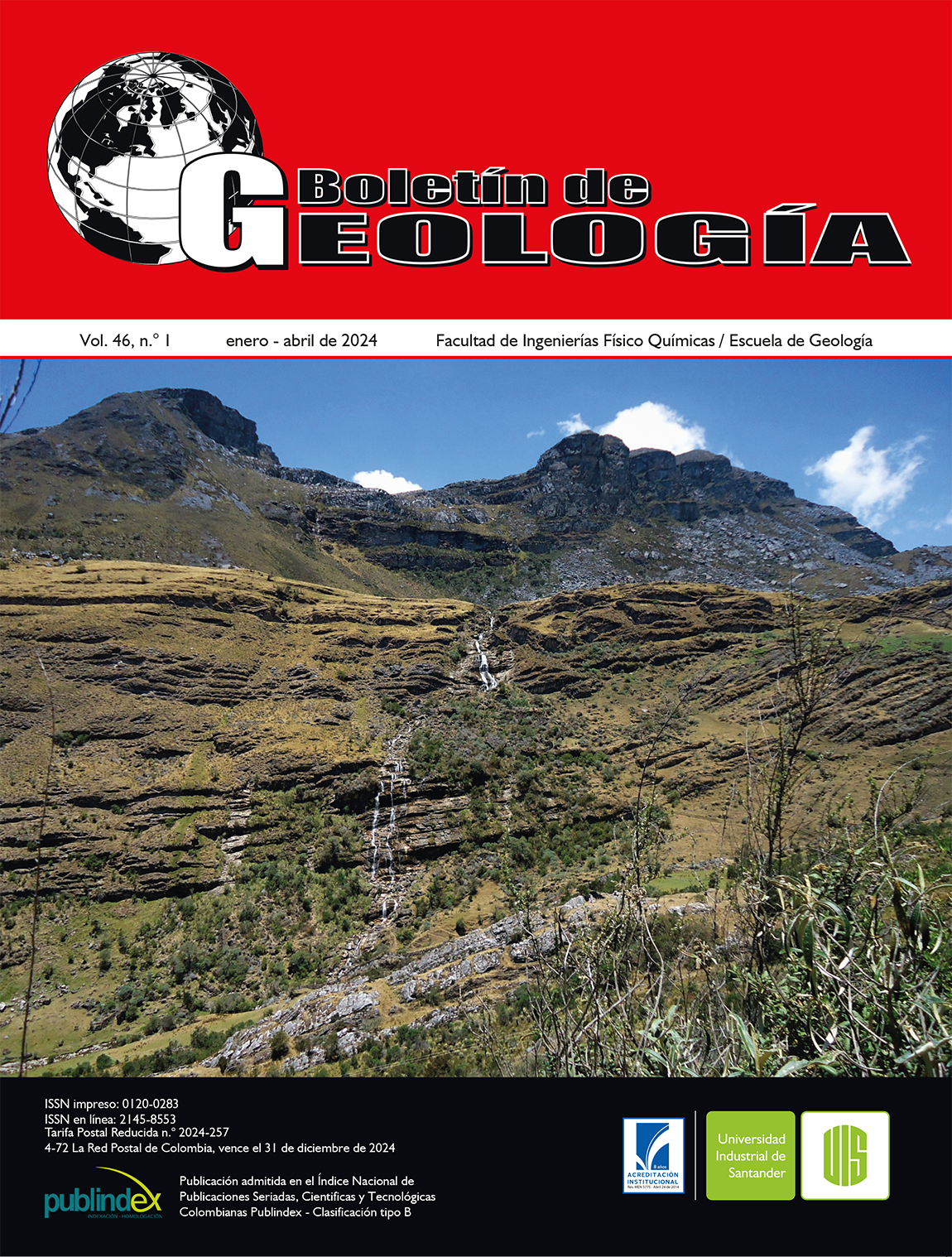Estimation of mud losses through fractures through mathematical modeling and its validation using a physical model
Published 2024-03-08
Keywords
- Rheology,
- Laboratory,
- Fracture flow,
- Numerical model
How to Cite
Copyright (c) 2024 Boletín de Geología

This work is licensed under a Creative Commons Attribution 4.0 International License.
Altmetrics
Abstract
Fluid loss can occur through fractured formations or in permeable zones, especially when low pressures are present. This event increases non-productive times in drilling operations, which increases costs. This generates the need to understand the interaction between the drilling fluid and the fractures present in the formation. For that purpose, a methodology is proposed that has two approaches, a numerical one based on rheological models and balance of the equation of movement, and a physical one based on the theory of scaling. For the numerical model, the equations that allow calculating the velocity profile as a function of the fluid properties and fracture geometry are proposed. For the physical model real rock samples are taken, the fracture is built with a controlled width and geometry, through which a mud is circulated, whose properties were scaled and determined in the laboratory. The results of the physical and numerical model were compared for different rheologies and fracture widths, concluding that the mathematical model does represent the loss phenomenon, especially for low viscosities. The results of the physical and numerical model were compared for different rheologies and fracture widths, concluding that the mathematical model does represent the loss phenomenon, especially for low viscosities. For high viscosities it is necessary to correct for roughness, but still, the result shows a similar trend, confirming that it reproduces the phenomenon.
Downloads
References
- Avila-Parra, J.S; Ramirez-Boada, C.A. (2019). Análisis de tiempos totales de perforación, identificación de mejores prácticas y selección de tiempos de referencia para aplicar a las campañas de perforación de un campo de ECOPETROL. Tesis de pregrado, Universidad Industrial de Santander, Bucaramanga, Colombia.
- Bratton, T.; Canh, D.V.; Van Que, N.; Duc, N.V.; Gillespie, P.; Hunt, D.; Li, B.; Marcinew, R.; Ray, S.; Montaron, B.; Nelson, R.; Schoderbek, D.; Sonneland, L. (2006). The nature of naturally fractured reservoirs. Oilfield Review, 18(2), 4-23.
- Hubbert, M.K. (1937). Theory of scale models as applied to the study of geological structures. GSA Bulletin, 48(10), 1459-1520. https://doi.org/10.1130/GSAB-48-1459
- Lietard, O.; Unwin, T.; Guillot, D.; Hodder, M. (1996). Fracture width LWD and drilling mud/LCM selection guidelines in naturally fractured reservoirs. European Petroleum Conference, Milan, Italy. https://doi.org/10.2118/36832-MS
- Lavrov, A.; Tronvoll, J. (2004). Modeling Mud Loss in Fractured Formations. Abu Dhabi International Conference and Exhibition, Abu Dhabi, United Arab Emirates. https://doi.org/10.2118/88700-MS
- Lavrov, A.; Tronvoll, J. (2005). Mechanics of Borehole Ballooning in Naturally-Fractured Formations. SPE Middle East Oil and Gas Show and Conference, Kingdom of Bahrain. https://doi.org/10.2118/93747-MS
- Lavrov, A. (2013). Numerical modeling of steady-state flow of a non-Newtonian power-law fluid in a rough-walled fracture. Computers and Geotechnics, 50(0266), 101-109. https://doi.org/10.1016/j.compgeo.2013.01.004
- Lavrov, A. (2015). Flow of truncated power-law fluid between parallel walls for hydraulic fracturing applications. Journal of Non-Newtonian Fluid Mechanics, 223, 141-146. https://doi.org/10.1016/j.jnnfm.2015.06.005
- Mejía, E.L.; Velandia, F.; Zuluaga, C.A.; López, J.A.; Cramer, T. (2012). Análisis estructural al noreste del volcán Nevado del Ruíz, Colombia - Aporte a la exploración geotérmica. Boletín de Geología, 34(1), 27-41.
- Moazzeni, A.R.; Nabaei, M.; Ghadami, S. (2011). Non-productive Time Reduction Through a Deep Rig Time Analysis: Case Study. SPE Digital Energy Conference and Exhibition. The Woodlands, Texas, USA. https://doi.org/10.2118/142799-MS
- Ozdemirtas, M.; Babadagli, T.; Kuru, E. (2009). Experimental and numerical investigations of borehole ballooning in rough fractures. SPE Drilling Completion, 24(02), 256-265. https://doi.org/10.2118/110121-PA
- Sanfillippo, F.; Brignoli, M.; Santarelli, F.J.; Bezzola, C. (1997). Characterization of conductive fractures while drilling. SPE European Formation Damage Conference, The Hague, Netherlands. https://doi.org/10.2118/38177-MS
- Sun, Y.; Huang, H. (2015). Effect of rheology on drilling mud loss in a natural fracture. 49th U.S. Rock Mechanics/Geomechanics Symposium, San Francisco, California.
- Vargas, D.A.; Calderon, Z.H.; Mateus, D.C. (2019). Assessment of the drilling fluid losses phenomenon in naturally-fractured reservoir by numerical modeling that couples fracture plane and permeable zone. ISRM 8th International Symposium Geomechanics, Bucaramanga, Colombia.
- Uribe-Joya, L.; Vargas-Silva; D.A. (2023). Physical model to simulate drilling fluid losses in low pressure zones. 10o Simposio Internacional de Geomecánica, Bucaramanga, Colombia.
- Xia, Y.; Jin, Y.; Chen, M. (2015a). Comprehensive methodology for detecting fracture aperture in naturally fractured formations using mud loss data. Journal of Petroleum Science and Engineering, 135, 515-530. https://doi.org/10.1016/j.petrol.2015.10.017
- Xia, Y.; Jin, Y.; Chen, M.; Chen, K.P.; Lin, B.T.; Hou, B. (2015b). Hydrodynamic modeling of mud loss controlled by the coupling of discrete fracture and matrix. Journal of Petroleum Science and Engineering, 129, 254-267. https://doi.org/10.1016/j.petrol.2014.07.026

